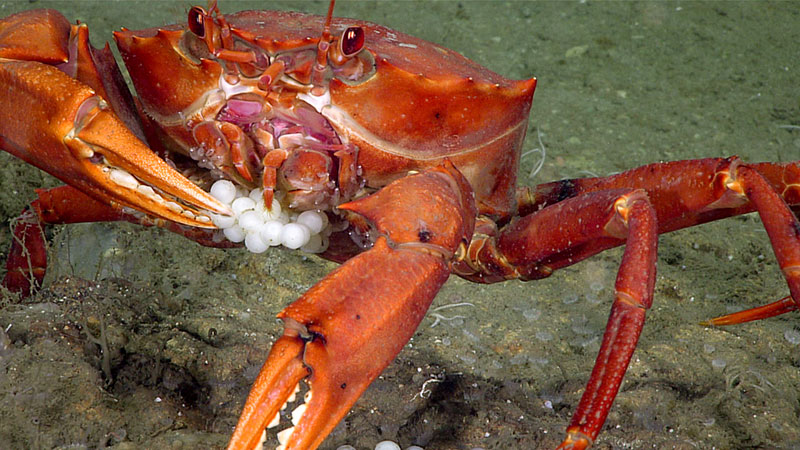What conditions exist for life in the deep ocean?
Organisms living in the deep ocean must be adapted to survive under extreme pressure, limited light, cold temperatures, and other factors.

Organisms living in the deep ocean must survive in a physical environment that is radically different from ocean habitats near the sea surface. In this photo, a red crab (Chaceon sp.) feeds on eggs, likely of a pallid sculpin. Image courtesy of the Office of Ocean Exploration and Research, Windows to the Deep 2019. Download image (jpg, 130 KB).
The conditions in the deep ocean are vastly different – and arguably more extreme – than those found in more shallow ocean waters, making these habitats different from other places on Earth.
As you travel from the surface of the ocean downward to the seafloor, water pressure increases by one atmosphere (or 14 pounds per square inch) for every 10 meters (32.8 feet) of depth. This means, for example, at 100 meters (328 feet), you would experience one atmosphere of air pressure and 10 atmospheres of water pressure, for a total of 11 atmospheres. Travel to 1,000 meters (3,280 feet) below the ocean’s surface and most organisms with gas-filled spaces (e.g., lungs) would be crushed by the pressures that other deep-sea life experience.
Light is virtually absent in the deep ocean, which means that deep-sea organisms cannot rely on vision for feeding, avoiding being eaten, or mating. Without sunlight, photosynthesis, the process by which plants make food, is not possible; this contributes to a general scarcity of food in the deep ocean and thus a lower overall density of organisms in many parts of the deep ocean. Chemosynthetic communities in the vicinity of hydrothermal vents and cold seeps are an exception, since they are not dependent upon photosynthesis as a primary food source.
The lack of light in the deep ocean also means that it is very cold down there; below about 200 meters (656 feet) depth, ocean waters have an average temperature of only 4°C (39°F).